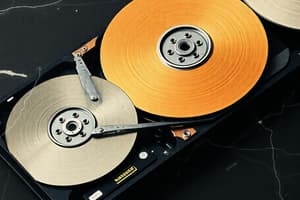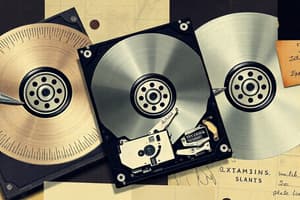Podcast
Questions and Answers
What does it indicate when you see a message 'cannot read from the source disk' when starting your computer?
What does it indicate when you see a message 'cannot read from the source disk' when starting your computer?
- The system is overheating
- The storage drive has failed (correct)
- The motherboard is damaged
- The data on the drive is corrupted
What could be a sign of a failing storage drive?
What could be a sign of a failing storage drive?
- Random shutdowns
- System underclocking
- Constant LED access activity on the drive light (correct)
- Reduced fan speed
What does the 'click of death' refer to in the context of storage drives?
What does the 'click of death' refer to in the context of storage drives?
- Notification sound for system updates
- Sound of system startup
- Noise from the cooling fan
- Loud clicking noise from a failing hard drive (correct)
What is the first recommended step to troubleshoot storage problems?
What is the first recommended step to troubleshoot storage problems?
What does SMART stand for in relation to storage drives?
What does SMART stand for in relation to storage drives?
How can SMART information be accessed?
How can SMART information be accessed?
What does a growing number of errors in SMART information indicate?
What does a growing number of errors in SMART information indicate?
How often do mini RAID arrays perform their own checks?
How often do mini RAID arrays perform their own checks?
What should be done if a message indicates that a drive is failing?
What should be done if a message indicates that a drive is failing?
What is one way to measure the overall performance of storage devices?
What is one way to measure the overall performance of storage devices?
What is the approximate maximum IOPS for a hard drive?
What is the approximate maximum IOPS for a hard drive?
What is the approximate maximum IOPS for a solid state drive?
What is the approximate maximum IOPS for a solid state drive?
What might be the cause if a drive is missing from the File Manager?
What might be the cause if a drive is missing from the File Manager?
What action might be taken if a missing drive is a network share?
What action might be taken if a missing drive is a network share?
What may cause computer issues with storage drives?
What may cause computer issues with storage drives?
What should be checked if new hardware has been added to a computer system?
What should be checked if new hardware has been added to a computer system?
What is the purpose of hardware diagnostics run by the drive manufacturer?
What is the purpose of hardware diagnostics run by the drive manufacturer?
What may operating system not found messages indicate?
What may operating system not found messages indicate?
What is the first step in troubleshooting when checking the physical configuration of a storage drive?
What is the first step in troubleshooting when checking the physical configuration of a storage drive?
What does the BIOS do if an operating system is not found during startup?
What does the BIOS do if an operating system is not found during startup?
What may cause boot issues related to USB drives?
What may cause boot issues related to USB drives?
What should be checked if a new storage drive is not recognized?
What should be checked if a new storage drive is not recognized?
What can help identify which SATA interface is operational?
What can help identify which SATA interface is operational?
What is necessary to prevent potential data loss from failing hard drives or SSDs?
What is necessary to prevent potential data loss from failing hard drives or SSDs?
What are RAID arrays used for?
What are RAID arrays used for?
What does a RAID array require for efficient functioning?
What does a RAID array require for efficient functioning?
Flashcards are hidden until you start studying
Study Notes
- Some computer issues with storage drives may be caused by overheating or overloading the power supply.
- If new hardware has been added, check if the power supply can handle the additional voltage requirements.
- Hardware diagnostics can be run by the drive manufacturer to check for any internal errors.
- During startup, various messages may appear indicating issues with drive recognition or boot devices.
- Operating system not found messages may indicate that the drive has been physically disconnected or that the operating system is corrupt.
- Checking the physical configuration of the storage drive, such as properly attaching cables to the motherboard, is the first step in troubleshooting.
- The BIOS maintains a list of priorities for boot devices. If an operating system is not found, the BIOS moves on to the next one in line.
- USB interfaces may cause boot issues if a USB drive is left connected and set as a priority in the BIOS.
- Data and power cables should be checked if a new storage drive is not recognized.
- Trying different SATA interfaces may help identify which one is operational.
- Hard drives are mechanical systems and will eventually fail. Constant backups are necessary to prevent data loss.
- SSDs can also fail and may only allow data to be read but not written.
- RAID arrays are used to combine drives and maintain data availability.
- The text mentions a RAID exception detected and offers the option of starting the Dell configuration utility to investigate.
- The text mentions RAID types, such as RAID 0, RAID 1, RAID 5, and RAID 10, each with different requirements and levels of redundancy.
- A RAID array requires multiple drives, and a single drive failure can result in different levels of data loss depending on the RAID type used.
Studying That Suits You
Use AI to generate personalized quizzes and flashcards to suit your learning preferences.




